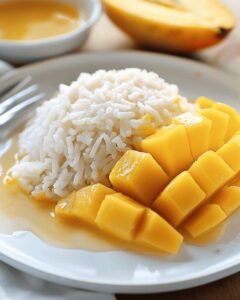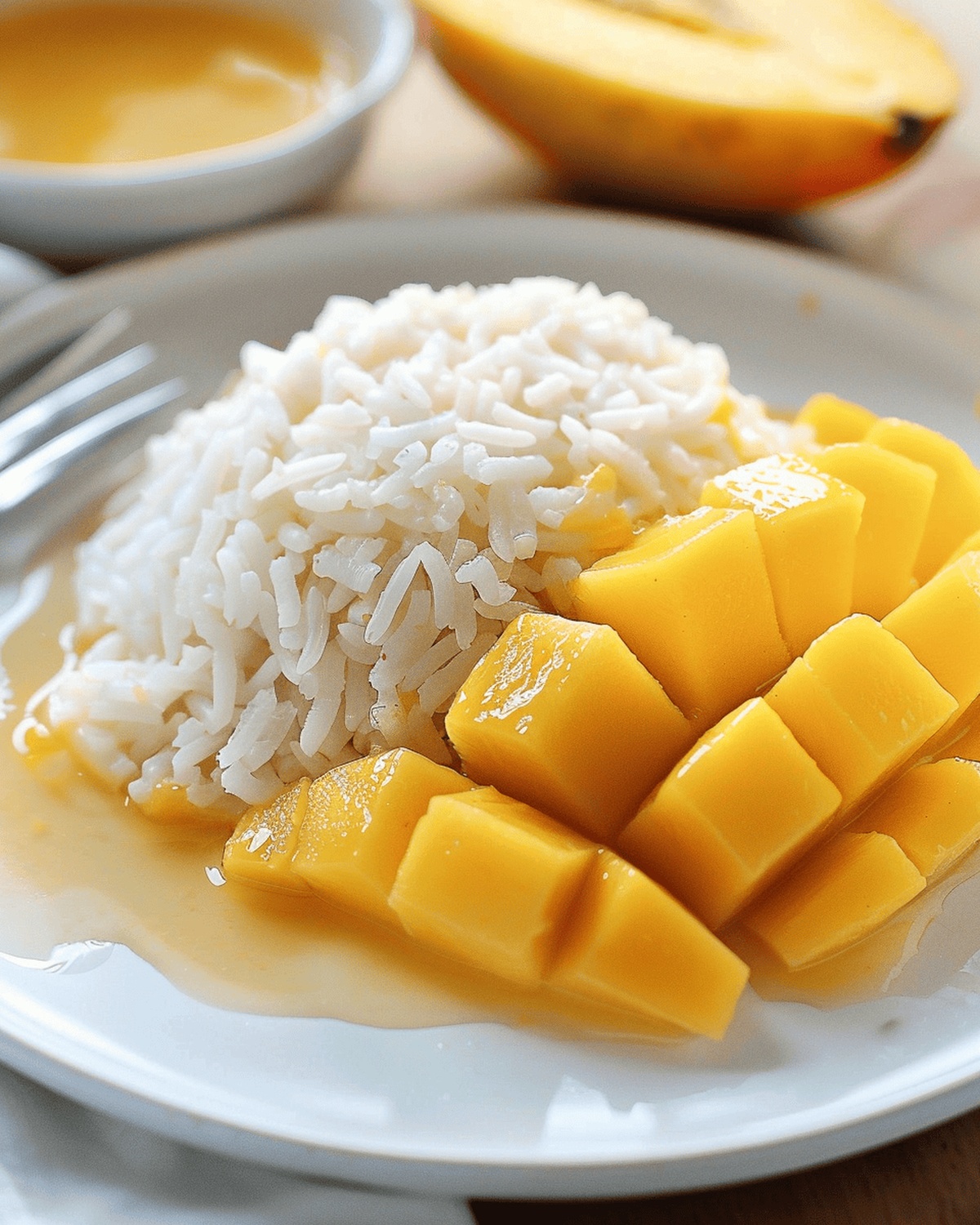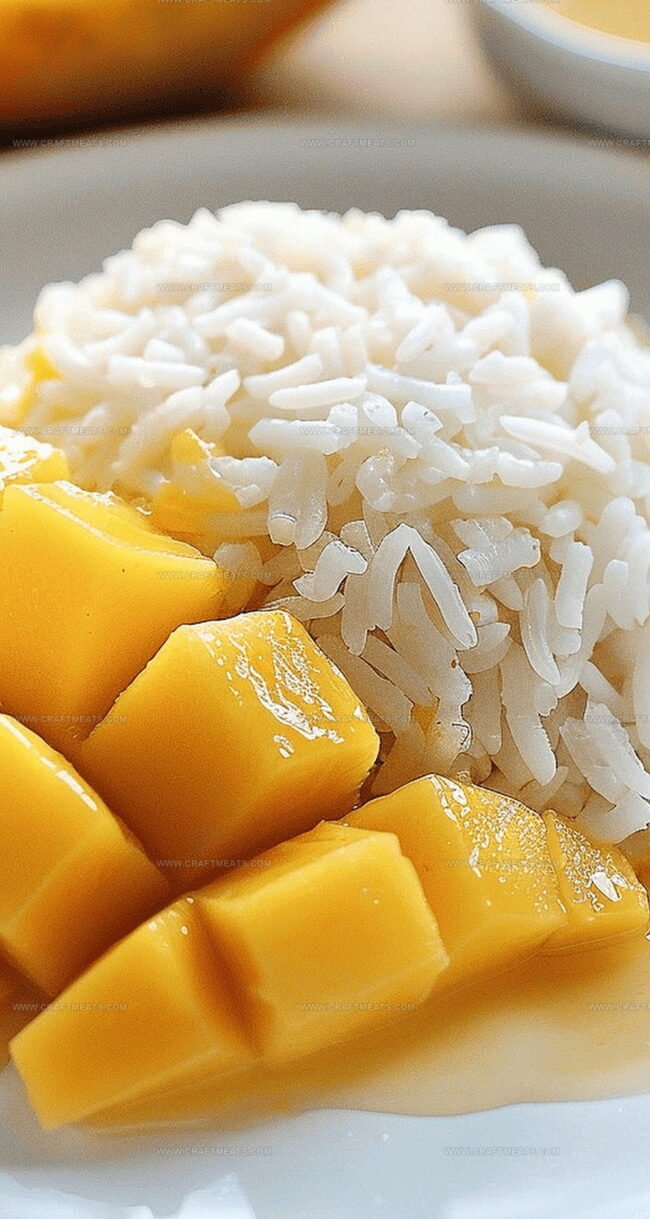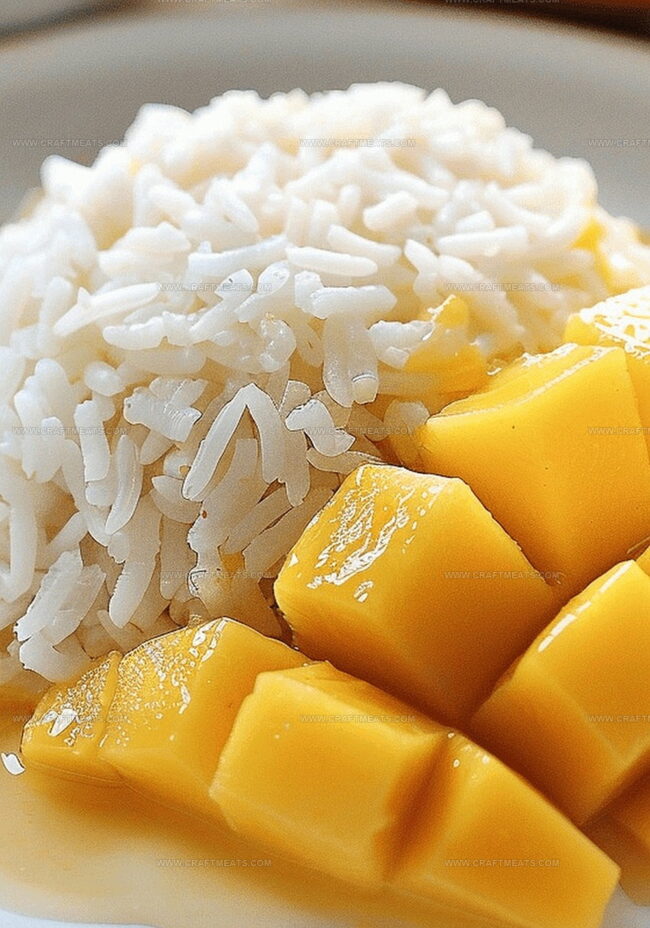Creamy Thai Mango Sticky Rice Recipe for Sweet Cravings
Sweet, creamy Thai mango sticky rice dances between tropical indulgence and comforting tradition.
Tropical fruits bring magic to this classic dessert, redefineing simple ingredients into a culinary masterpiece.
Vibrant mangoes complement the rich, coconut-infused rice, creating a harmonious blend of textures and flavors.
Each bite tells a story of cultural heritage and delightful sensory experiences.
Soft, glutinous rice absorbs luxurious coconut milk, developing a silky smooth consistency that melts on your tongue.
The delicate balance between sweet and creamy makes this dessert irresistibly tempting for anyone seeking a refreshing treat.
Seasonal mangoes elevate the dish with their natural sweetness and bright color, promising a memorable gastronomic journey.
Why Thai Mango Sticky Rice Is a Sweet Classic
Ingredients for Thai Mango Sticky Rice Dessert
Main Rice Components:Liquid and Sweetening Ingredients:Finishing and Garnish Components:How to Make Traditional Mango Sticky Rice at Home
Step 1: Soak Rice Thoroughly
Place glutinous rice in cold water. Let it soak for 4-8 hours or overnight. This softens the rice and helps it cook evenly. After soaking, drain completely using a fine-mesh strainer.
Step 2: Steam Rice Perfectly
Set up a steamer or create a makeshift steaming setup. Steam rice for 20-25 minutes. Check occasionally to ensure rice becomes tender but maintains a slight chewiness. Avoid overcooking.
Step 3: Prepare Sweet Coconut Sauce
In a saucepan, combine:Bring mixture to a gentle boil. Reduce heat and simmer. Mix cornstarch with a small amount of coconut milk, then add to the sauce. Stir continuously until sauce thickens slightly.
Step 4: Infuse Rice with Coconut Flavor
Transfer cooked rice to a large bowl. Pour half the coconut sauce over rice. Gently fold to distribute sauce evenly. Let rice rest for 15-20 minutes to absorb flavors.
Step 5: Prepare Mango Slices
Wash mangoes. Peel carefully using a sharp knife. Cut into elegant, bite-sized pieces. Choose ripe, sweet mangoes for the best taste.
Step 6: Assemble and Serve
Arrange rice on serving plates. Place mango slices artfully around or on top of rice. Drizzle remaining coconut sauce generously. Sprinkle sesame seeds for extra texture and visual appeal.
Step 7: Final Touches
Serve immediately while rice is warm and mangoes are fresh. Enjoy the delightful combination of sweet, creamy, and tropical flavors.
Tips for Perfectly Sticky Rice and Juicy Mango
Best Way to Store and Reheat Mango Sticky Rice
What Goes Well with This Thai Dessert
Creative Mango Sticky Rice Twists to Try
Print
Thai Mango Sticky Rice Recipe
- Total Time: 2 hours 30 minutes
- Yield: 4 1x
Description
Silky Thai mango sticky rice brings sweet coconut comfort from Southeast Asian kitchens. Rich glutinous rice paired with ripe mangoes creates a dreamy dessert you cannot resist.
Ingredients
Rice and Main Ingredients:
- 1 cup glutinous (sweet) rice
- 2–3 fresh mangoes, peeled and sliced
Liquid and Sweetener Ingredients:
- 1 cup (240 milliliters) coconut milk
- 1 tablespoon (15 milliliters) coconut milk
- ¼ cup (50 grams) sugar
- ¼ teaspoon salt
Thickening and Garnish Ingredients:
- ½ teaspoon cornstarch
- ½ teaspoon sesame seeds
Instructions
- Immerse glutinous rice in cold water for a minimum of 2 hours, allowing the grains to soften and prepare for even cooking. Longer soaking time enhances rice texture and absorption capacity.
- Thoroughly drain the rice, eliminating excess liquid to prevent potential waterlogging during the cooking process.
- Utilize a steaming apparatus – traditional bamboo steamer or improvised setup with a perforated container suspended over boiling water. Steam rice for approximately 25 minutes until grains become tender yet maintain structural integrity.
- While rice transforms, meticulously peel ripe mangoes and slice into elegant, uniform pieces that will complement the sticky rice’s texture.
- Create a luscious coconut sauce by gently heating coconut milk with sugar and a whisper of salt. Allow ingredients to meld and transform, stirring consistently to prevent scorching.
- Introduce cornstarch mixture to the simmering sauce, continuously whisking until the liquid develops a silky, slightly thickened consistency that coats the back of a spoon.
- Transfer steamed rice into a spacious mixing vessel, then integrate half the prepared coconut sauce. Allow the rice to rest and absorb the fragrant liquid, developing deeper flavor profiles.
- Artfully plate the infused sticky rice, surrounding or topping with vibrant mango slices. Cascade remaining coconut sauce over the composition and sprinkle toasted sesame seeds for textural contrast and visual elegance.
Notes
- Dive into the vibrant world of Thai desserts with this mango sticky rice recipe that promises a sweet, creamy adventure.
- Soaking glutinous rice overnight transforms ordinary grains into a luxurious, tender base that’s the heart of this classic Southeast Asian treat.
- Perfectly ripe mangoes and silky coconut sauce create a harmonious balance of flavors that dance across your taste buds.
- Prep Time: 2 hours
- Cook Time: 30 minutes
- Category: Desserts, Snacks
- Method: Steaming
- Cuisine: Thai
Nutrition
- Serving Size: 4
- Calories: 300
- Sugar: 20g
- Sodium: 60mg
- Fat: 9g
- Saturated Fat: 8g
- Unsaturated Fat: 1g
- Trans Fat: 0g
- Carbohydrates: 54g
- Fiber: 2g
- Protein: 4g
- Cholesterol: 0mg




Isabella Rossi
Founder & Culinary Content Creator
Expertise
Recipe Development, Traditional Irish and European Cuisines, Food Styling and Photography, Culinary Education
Education
Dublin Institute of Technology (DIT) – School of Culinary Arts and Food Technology
Ballymaloe Cookery School
Liam is the voice behind many of Craft Meats’ most flavorful features. With roots in Dublin’s smoky barbecue scene and a culinary degree from the Dublin Institute of Technology, he brings time-tested cooking techniques to life.
His training at Ballymaloe Cookery School sharpened his farm-to-table approach, giving him a deep respect for every ingredient he writes about.
He’s not about overcomplicating the process, just helping you cook meat that’s worth talking about. When he’s not writing or grilling, he’s out foraging or nerding out on regional spice blends to add to his next recipe.